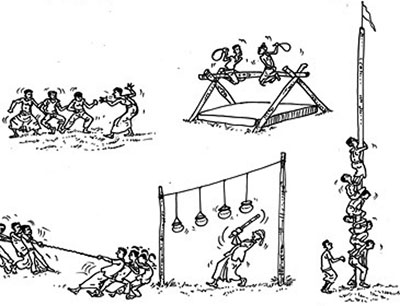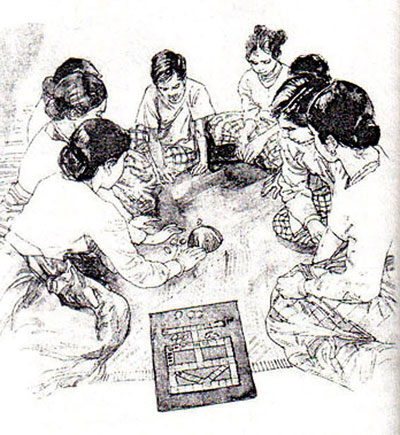Avurudu Games
View(s):By Shakya Wickramanayake
 It’s that time of the year once again, when our little Island prepares to celebrate the dawn of the Sinhala and Tamil New Year. Let’s look at some of
It’s that time of the year once again, when our little Island prepares to celebrate the dawn of the Sinhala and Tamil New Year. Let’s look at some of
the games typically played during the ‘Aluth Avurudda’ as it is known in Sinhala or ‘Puththandu’ in Tamil.
‘Kana Mutti Bindeema’ is a popular Avurudu game. It involves several clay pots filled with either sand or water hung in a row, with one pot being filled with blue water. The aim of the game is to hit and break the pot that contains the blue water. Players are given a bamboo stick to break the pots. But first, they are blindfolded and spun around three times, before they can attempt to do so.
Another popular game is ‘Kotta Pora’ or the pillow fight game. Played by two people at a time, players sit on either side of a horizontal pole that is suspended above the ground. Each player has one hand tied behind their backs and are given a pillow, with which they must hit the other until one person falls off the pole. The player who manages to stay on the pole for most of the rounds, wins the game.
A game typically played by the younger children is placing the eye on the elephant or ‘Aliyata esa thabeema’ . Here, participants, who are blindfolded, attempt to place the eye on an image of an elephant. The person who places it closest to where the eye should be, wins.
Climbing the grease pole or ‘Lissana Gaha Nageema’ is a fun but difficult game to play. Players must climb to the top of a grease covered pole and retrieve the flag placed at the top. The winner is the player that is the first to get the flag. The grease makes the pole very slippery, making it difficult for most players to climb up without sliding back down.
The bun eating game or ‘Banis Kaama’ requires participants to eat buns that have been hung up by strings, whilst their hands are tied behind their backs. The first person to finish the whole bun, wins.
A game usually played by women is the coconut scraping competition or ‘Pol Gaamey Tharangaya’. Here, competitors sit on a stool which has a coconut scraper, known as a ‘Hiramanaya’, and compete to be the first to finish scrapping the coconuts.
The Lime & Spoon race, requires players to have a good sense of balance. The handle of a spoon is placed in the mouths of the players and a lime is placed in the spoon. Players must then run to the finish line whilst balancing the lime, and not allowing it to fall.
 Besides all these outdoor games there are also indoor Avurudu games. Namely ‘Olinda Keliya’ and ‘Pancha Keliya’, which are both board games.
Besides all these outdoor games there are also indoor Avurudu games. Namely ‘Olinda Keliya’ and ‘Pancha Keliya’, which are both board games.
‘Olinda Keliya’ or Mancala, is played using olinda seeds on a wooden board. Players sit on either side of the board and play by filling the pits carved into the face of the board with the olinda seeds. The rules of the game differ from region to region, but the winner is the player who collects the most amount of seeds by the end of the game.
‘Pancha Keliya’ or Game of Five, is played using five seashells, a coconut shell and a chart. Players are divided into two groups. Players move the pieces on the spaces in the chart. The number of spaces they may move is determined by the number of shells that have overturned after shaking them in the coconut shell. The first team to get all three of their pieces to the end, wins the game.
Many families and communities still celebrate the New Year with these traditional games.


